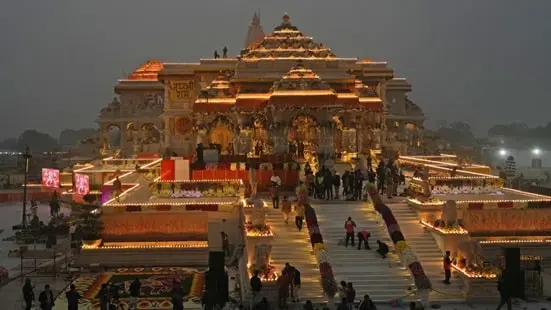The Ram Mandir is expected to be one of the largest and most magnificent Hindu temples in the world. Situated on the eastern shores of the River Saryu, Ayodhya is an embodiment of Indian values and traditions. With its historical and mythological eminence, this city holds a high place of honor in the revered epics of Ramayan and Shri Ramcharitmanas. Draped across the landscape, Ayodhya's grandeur lends an apropos background to the mythological tale of Lord Rama. Among its many locales is Ram Janmabhoomi, a location crowded with pilgrims and also one that attracts tourists to the Ram Mandir here.
As one plans to visit this divine adobe, timing becomes crucial for a truly enchanting experience. This article takes into respect the best several times when one can ideally visit Ram Mandir at Ayodhya taking into respect the each season has its charm it carries along.

Ayodhya's mild weather makes it ideal from October to March. Temperatures range from 5 to 27 degrees Celsius, making exploration enjoyable. The Ram Mandir's spirituality and the city's history are best explored in winter owing to its cold breeze and wonderful weather.
Diwali in October or November is a season highlight. This incident illuminates Ayodhya. Beautiful lights and decorations make Ram Mandir stand out. Temple visitors and pilgrims may enjoy the spiritual festivals and festive splendor.
Winter in Ayodhya is amazing because of Diwali and excellent weather. This city's history and spirituality inspire delight and dedication. Visitors may see the Ram Mandir and experience the festivities, creating lasting memories of a breathtaking journey.
From July to September, the monsoon provides moderate to heavy rain to Ayodhya. City becomes a lush sanctuary in the rainy season. Monsoon Ram Mandir pilgrims should be cautious since heavy rains may hinder sightseeing. The temperature stays at Twenty-four to thirty degrees Celsius.
Ayodhya shines in the monsoon despite its trials. The Saryu River surges, makes the area lush and beautiful. Monsoons boost the city's cultural and spiritual milieu, providing rainy season fans a fresh perspective.
While the monsoon is charming, travelers seeking a peaceful and easy trip may avoid it. Heavy rains may disrupt visitor plans and make city mobility tougher, ruining the experience. A more temperate atmosphere may make Ram Mandir and its surroundings more comfortable for pilgrims and tourists.
In April–June, Ayodhya's summer temperatures reach 28–45 degrees Celsius. These months are extremely hot for tourists, particularly beginners. Visitors may struggle to find spiritual peace at the Ram Mandir in hot weather.
While summer is bad for temple visits, Ayodhya gets less visitors. Heat-tolerant travelers may enjoy Ayodhya more calmly with less people. In the summer, visitors must emphasize their comfort and well-being.
Enjoying Ayodhya in the heat requires planning. Sunscreen, drink, and suitable clothing are needed in summer. Although fewer people may provide privacy, inclement weather may create challenges.
Ayodhya in summer is less crowded and more intimate, but the heat is brutal. Personal well-being and comfort are essential for summer pilgrimages and trips to maximize spirituality and minimize weather affects.
The spiritual and historical significance of Ayodhya lure travelers year-round. An icon of devotion and architecture, the Ram Mandir embodies India's culture. Ayodhya and the Ram Mandir are best visited in winter, October to March, when the weather is nice and the festivities are fun.
When one plans his pilgrimage or tourist expedition to Ayodhya, the seasonal variations become an imperative factor for their fulfilling. Each season presents a unique perspective on the charm of the city, and each time helps the pilgrims or tourist contact its spiritual and historical essence in other way. Be it the colorful celebrations of winter or the sizzling foliage of monsoon, Ayodhya is open to every season and gives a chance to experience divinity through one in all the seasons.